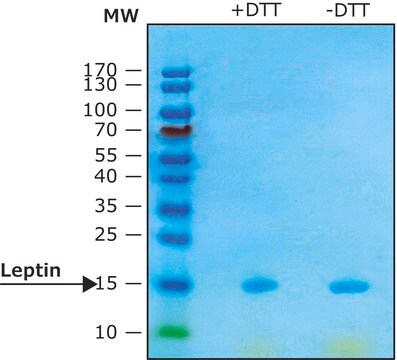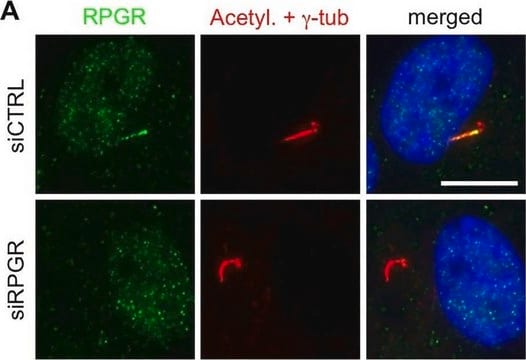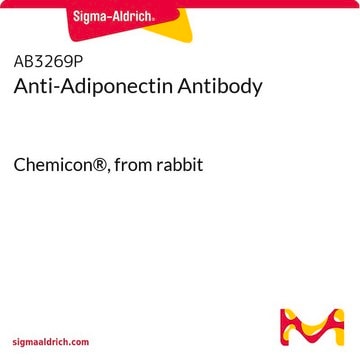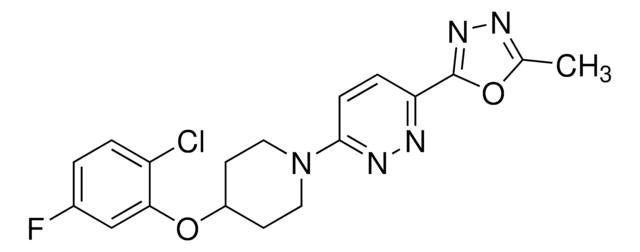SRP4902
Adiponectin from mouse
recombinant, expressed in E. coli, ≥90% (SDS-PAGE)
Synonym(s):
ACDC, APM-1, Acrp30, AdipoQ, GBP-28
Sign Into View Organizational & Contract Pricing
All Photos(1)
About This Item
UNSPSC Code:
12352202
NACRES:
NA.32
Recommended Products
biological source
mouse
recombinant
expressed in E. coli
Assay
≥90% (SDS-PAGE)
form
lyophilized
mol wt
~30 kDa
packaging
pkg of 25 μg
storage condition
avoid repeated freeze/thaw cycles
impurities
endotoxin, tested
NCBI accession no.
shipped in
wet ice
storage temp.
−20°C
Gene Information
mouse ... Adipoq(11450)
General description
Acrp30 (adipocyte complement-related protein), or cytokine adiponectin, is a hormone produced and secreted by differentiated adipocytes. This protein is composed of an N-terminal collagenous domain and a C-terminal globular trimerization domain. It exists in plasma predominantly as trimeric, hexameric or other high-molecular weight forms. The globular subunit gAcrp30 is however absent in plasma and is biologically active. gAcrp30 is the truncated form of full length of Acrp30, and functions as a ligand of AdipoR1.
Application
Adiponectin from mouse has been used for the treatment of 3T3-L1 cells, along with TNFα (tumor necrosis factor), to determine TNFα inhibition of adiponectin activities by examining lipid accumulation and glucose uptake. It has also been used for the pretreatment of TM3 cells, to study its influence on attenuation of proinflammatory cytokine expression in TM3 cells upon treatment with TNF-α or IL-1β (interleukin).
Biochem/physiol Actions
In obese mice and humans, adiponectin mRNA expression is reduced, therefore linking this hormone to energy homeostasis. In incubated mouse muscle and cultured cells, gAcrp30 leads to an increase in fatty acid oxidation. This hormone is also linked to anti-atherogenesis, and in apoE-deficient mice, overexpression of gAcrp30 results in significant attenuation of atherosclerosis. Long-term administration of this hormone in mice results in weight loss without reduction in food intake. This hormone is capable of reducing proliferation of MDA-ERα7 cell line. Studies show that ratio of gAcrp30 to leptin and the ERα(estrogen receptor alpha) status of cells are key in determining BRCA (breast cancer) cell growth.
Physical form
Lyophilized from a 0.2 μm filtered solution in 25 mM Tris, 0.15 M NaCl, pH 7.4 containing 50 μg of bovine serum albumin (BSA) per 1 μg of adiponectin.
Reconstitution
Centrifuge the vial prior to opening. Avoid freeze-thaw cycles.
Recontitute in PBS containing at least 0.1% BSA to a concentration of 0.1-1.0 mg/mL. This stock solution can then be diluted into other aqueous buffers and stored at 4°C for 1 week or –20°C for future use.
Storage Class Code
11 - Combustible Solids
WGK
WGK 3
Flash Point(F)
Not applicable
Flash Point(C)
Not applicable
Certificates of Analysis (COA)
Search for Certificates of Analysis (COA) by entering the products Lot/Batch Number. Lot and Batch Numbers can be found on a product’s label following the words ‘Lot’ or ‘Batch’.
Already Own This Product?
Find documentation for the products that you have recently purchased in the Document Library.
Adiponectin protects Leydig cells against proinflammatory cytokines by suppressing the nuclear factor-?B signaling pathway.
Wu L, et al.
FEBS Journal, 280(16), 3920-3927 (2013)
ACRP30/adiponectin: an adipokine regulating glucose and lipid metabolism.
Berg AH, et al.
Trends in Endocrinology and Metabolism, 13(2), 84-89 (2002)
Dongying Xuan et al.
Journal of cellular physiology, 231(5), 1090-1096 (2015-09-25)
Emerging evidence suggests an important role for epigenetic mechanisms in modulating signals during macrophage polarization and inflammation. JMJD3, a JmjC family histone demethylase necessary for M2 polarization is also required for effective induction of multiple M1 genes by lipopolysaccharide (LPS).
Interplay of pro- and anti-inflammatory cytokines to determine lipid accretion in adipocytes.
Wang Y, et al.
International Journal of Obesity, 37(11), 1490-1498 (2013)
Metabolic and hormonal interactions between muscle and adipose tissue.
Tomas E et al
The Proceedings of the Nutrition Society, 63(2), 381-385 (2004)
Articles
Lipid Induced Insulin Resistance
Our team of scientists has experience in all areas of research including Life Science, Material Science, Chemical Synthesis, Chromatography, Analytical and many others.
Contact Technical Service








